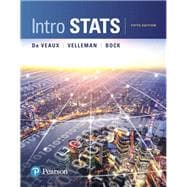NOTE: Before purchasing, check with your instructor to ensure you select the correct ISBN. Several versions of the MyLab™ and Mastering™ platforms exist for each title, and registrations are not transferable. To register for and use MyLab or Mastering, you may also need a Course ID, which your instructor will provide.
Used books, rentals, and purchases made outside of Pearson
If purchasing or renting from companies other than Pearson, the access codes for the MyLab platform may not be included, may be incorrect, or may be previously redeemed. Check with the seller before completing your purchase.
For courses in Introductory Statistics.
This package includes MyLab Statistics.
Encourages statistical thinking using technology, innovative methods, and a sense of humor
Inspired by the 2016 GAISE Report revision, Intro Stats, 5th Edition by De Veaux/Velleman/Bock uses innovative strategies to help students think critically about data — while maintaining the book’s core concepts, coverage, and most importantly, readability.
By using technology and simulations to demonstrate variability at critical points throughout the course, the authors make it easier for students to understand more complicated statistical later in the course (such as the Central Limit Theorem). In addition, students get more exposure to large data sets and multivariate thinking, which better prepares them to be critical consumers of statistics in the 21st century.
The 5th Edition’s approach to teaching intro stats is revolutionary, while retaining its lively tone and popular features such as Think/Show/Tell examples.
Reach every student by pairing this text with MyLab Statistics
MyLab™ Statistics is the teaching and learning platform that empowers instructors to reach every student. By combining trusted author content with digital tools and a flexible platform, MyLab Statistics personalizes the learning experience and improves results for each student. With MyLab Statistics and StatCrunch, an integrated web-based statistical software program, students learn the skills they need to interact with data in the real world.
0134210239 / 9780134210230 Intro Stats Plus NEW MyLab Statistics with Pearson eText - Access Card Package, 5/e
Package consists of:
-
0134210220 / 9780134210223 Intro Stats, 5/e
-
0134768361 / 9780134768366 MyLab Statistics with Pearson eText - Standalone Access Card - for Intro Stats 5/e








